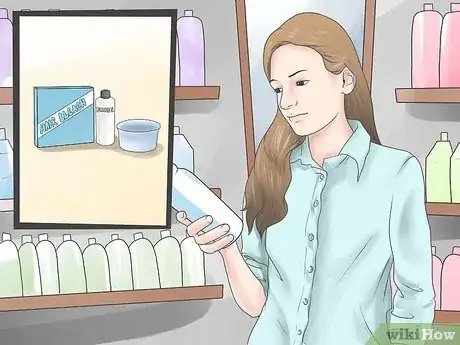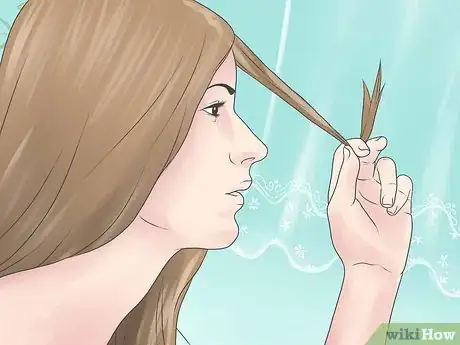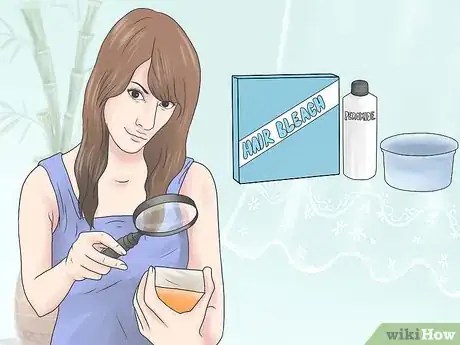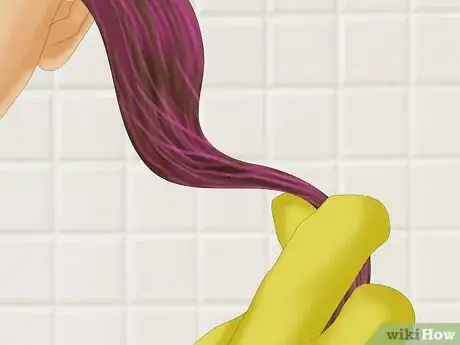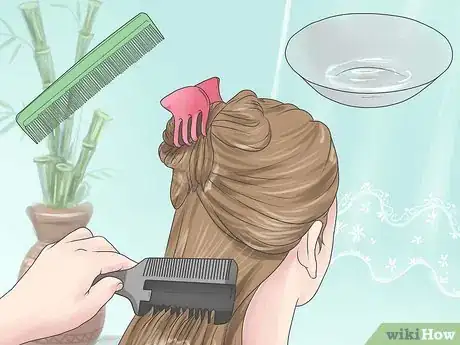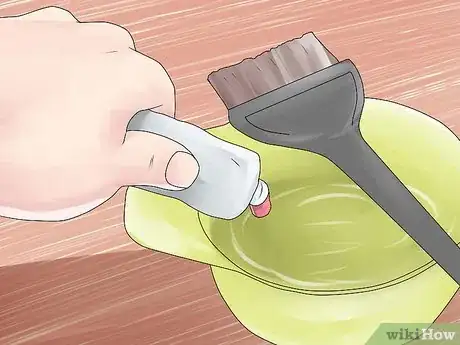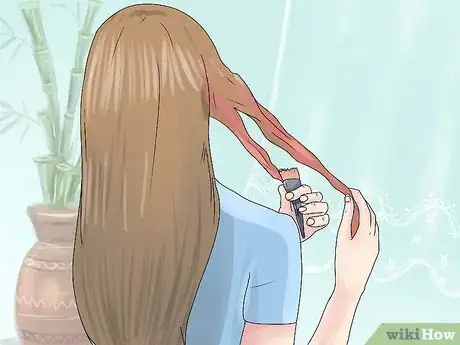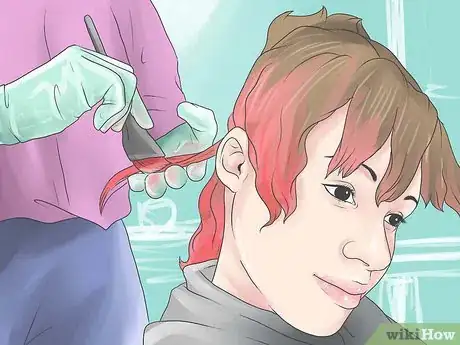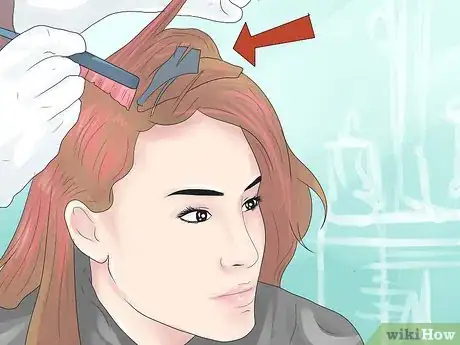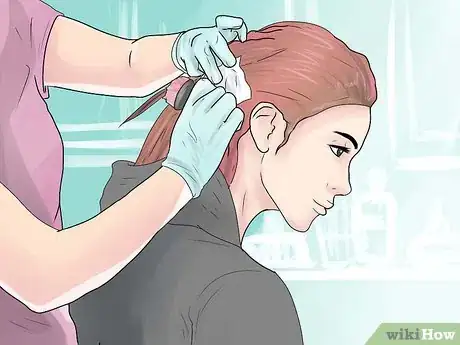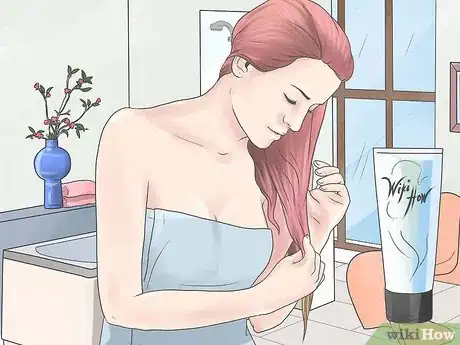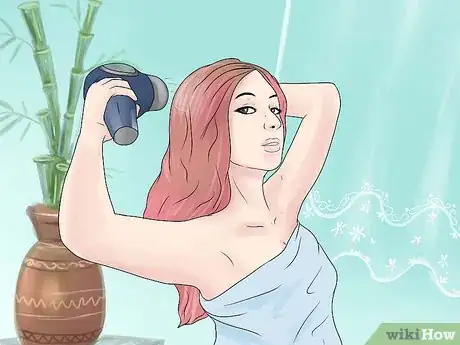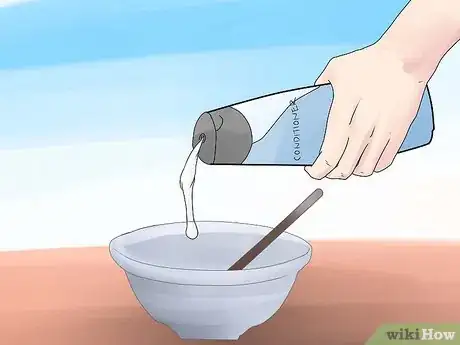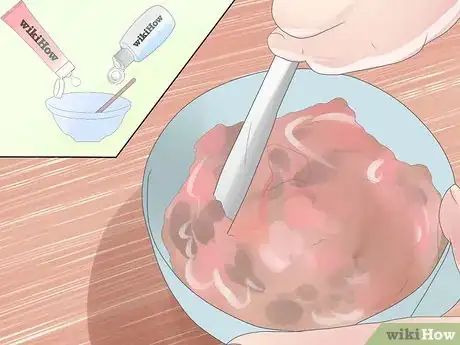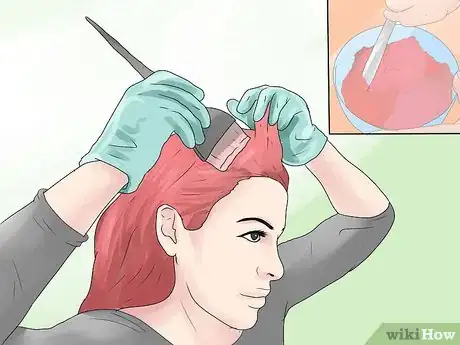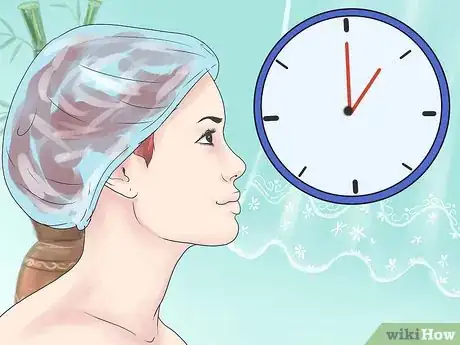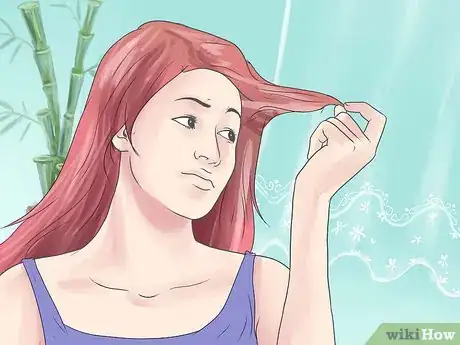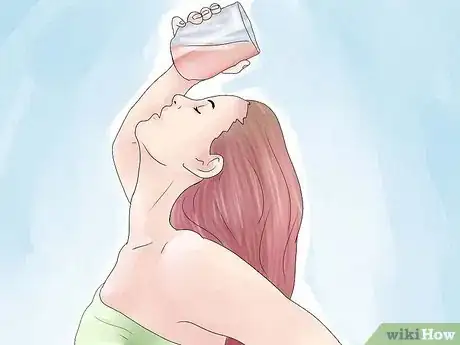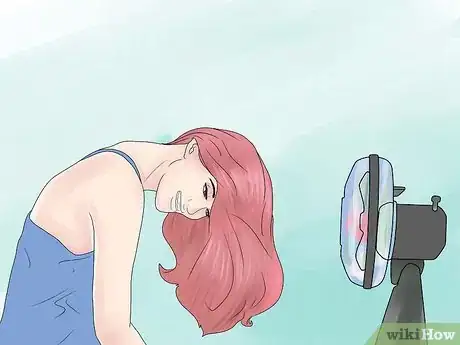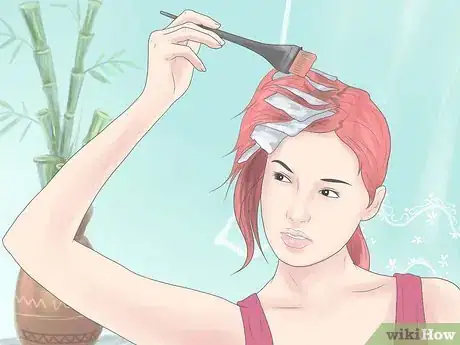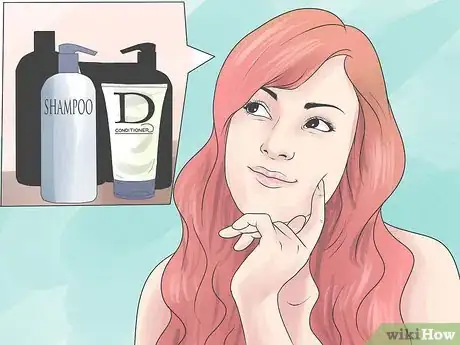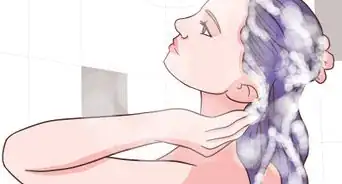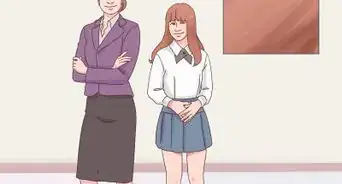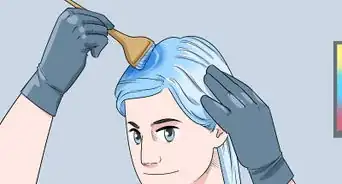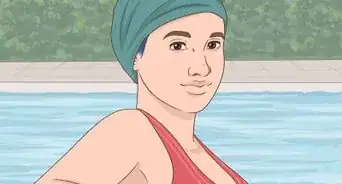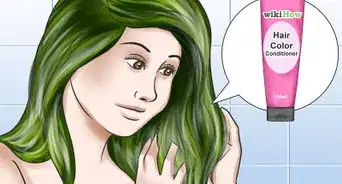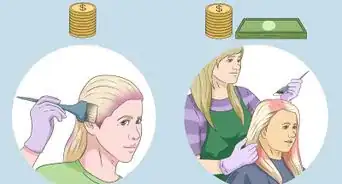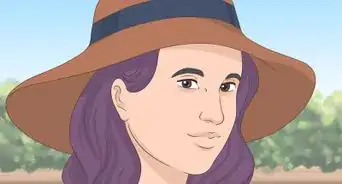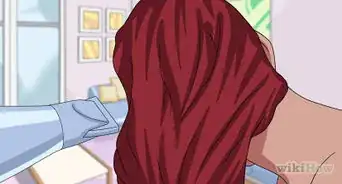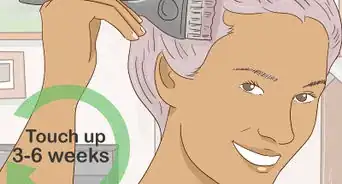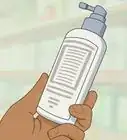This article was co-authored by Brianna Bowling. Brianna Bowling is a Hair Stylist and the Co-Owner of The CRAFT Salon in Glendora, California. With more than 11 years of experience, she specializes in balayage, blonding, and vivid colors. Brianna has received years of in-depth training on advanced color techniques.
wikiHow marks an article as reader-approved once it receives enough positive feedback. In this case, 100% of readers who voted found the article helpful, earning it our reader-approved status.
This article has been viewed 696,402 times.
Want to try something new with your hair? Then look no further! Dyeing your hair pastel colors can give it a unique look. Before getting this funky look, you will need to bleach your hair. Scroll down to Step 1 to start you on your path to pastel hair!
Steps
Bleaching Your Hair
-
1Choose your bleach. If your hair is not platinum blonde or white, you will need to bleach your hair. The lighter your hair, the better the pastel color will take. If this is your first time bleaching your hair, start with a bleach kit. The kit contains dye and peroxide to bleach your hair.
- Bleach kits will be labeled as white, blue, or purple. Blue and purple add in cool tones to help combat brassy-ness. Blue is more ideal for canceling out orange hair, and purple is best for yellow. White bleach is normal, with no added tones.
- If this is your first time bleaching or dyeing your hair at home, you may want to seriously consider going to a hair salon to get your hair bleached. Bleaching is the hardest part of this whole pastel hair process and improperly bleached hair can end up looking really fried and dead. Consider going to a hair salon to get your hair bleached and they do the pastel dyeing yourself (or have them do the whole thing).
-
2Make sure your hair is not freshly shampooed before you begin bleaching. Bleach will irritate your skin when it comes in contact with your scalp. To avoid this, or at least lessen the irritation, you should not wash your hair for several days before you plan on bleaching it. The natural oils of your hair will help to reduce the irritation caused by the bleach.
- Using a toner over already yellowy-blonde hair may be enough to lighten your hair. Try this before using bleach. Virgin Snow by Manic Panic is a great toner and won't set you back too much cash.
- Alternatively, if the toner just doesn't cut it you may use a bleaching method such as this. A less harmful way to lighten your hair is a bleach bath. (a bleach bath is a mixture of half bleach, half shampoo)
Advertisement -
3Choose your kit based on the developer.[1] The developer (peroxide) comes in either 10, 20, 30, or 40 volume. Bleach kits will not contain 10 volume, however, because it is not meant for this use. Do not use a kit with 40 volume developer, it is too strong and can damage your hair badly.[2]
- If your hair is already light blonde, use a 10 volume developer. While you may find it odd to bleach your hair when you are already blonde, using a 10 volume developer will help to open up your hair and make it more receptive to the pastel dye.
- If your hair is light to medium brown or strawberry blonde, use a 20 volume developer.
- If your hair is dark brown or black, use a 30 volume developer.
- Keep in mind, the higher the volume of developer, when you use it with bleach, or determines how FAST it processes. NOT how light your hair will get.
-
4Perform a strand test.[3] Strand tests will help you to see how long you need to process your hair. Section off a small piece of hair and make sure to keep it away from the rest of your hair. Mix one spoonful of the bleaching powder from your kit with one spoonful of the peroxide developer.
- Dip your small section of hair into the mixture. Wait five minutes and then wipe the dye off with a cloth. Continue dipping the strands and waiting five minutes until the strands are the color you want your hair to be. This amount of time will be how long your need to bleach your whole head of hair for.
- Do not rely on the results of your strand test too heavily. Different areas of hair will process at different speeds, and might even have different chemicals on them.
-
5Prepare your bleaching area. This will be the same area you dye your hair in. Lay down old towels (ones that you don’t mind staining) or newspapers on any of the surfaces near where you will be working, as dye has a tendency to stain everything it touches. You will also need a tint brush with a pointed handle, some latex (or rubber) gloves, and a non-metallic bowl. You should also place an old towel around your shoulders.
- If possible, ask a friend to help you with the actual bleaching process, as it can get a little tricky to just do by yourself.
- If your bleaching kit did not come with a tint brush, you can buy one at any beauty supply store.
-
6Mix the lightener packet and developer. Follow the directions on the bleach kit box to properly mix up the bleach. You will want to use a bowl that you do not care about or that is white, as bleach can suck the color right out of ceramics. Plastic bowls are the best for mixing dyes.
-
7Divide your hair into sections. Use the pointy handle of your tint brush to divide your hair down the middle of your head so that your part is directly in the middle of your hair. Then divide your hair from ear to ear so that you have four sections of hair. Use plastic clips to hold these sections in place.
- Don’t use metal clips; they may have a chemical reaction with the bleach.
-
8Bleach your hair.[4] If you have a friend around, now is the time to ask for their assistance. If not, make sure you are standing in front of a mirror so you can see what you are doing. Take a thin section of hair from the top of one of the back quarters. ‘Paint’ that strand with the dye, starting 1cm (0.39 inches) to 2.54cm (1 inch) away from your root and going all the way down to the bottom of the strands. Brush your hair with the dye from top to bottom (the direction that your hair grows) leaving your roots at the top uncovered (you will dye it later.)[5]
- You should wait until later on to bleach your roots because roots tend to process quicker than the rest of a strand of hair.
-
9Flip the dyed strand over. Repeat the same process with the strand below each dyed later, continuing to flip each dyed layer over to reveal the next layer of undyed hair. You will have to work quickly, as bleach starts working almost immediately. When you are done with one quarter, move onto the next until all of the quarters of hair are dyed.
-
10Add a second layer of bleach to the first quarter you dyed. Do this when that quarter of hair has turned golden blonde. This time, run the tint brush from the root of your hair all the way to the end of each strand. Repeat this process with each section of hair.
-
11Monitor your hair color. When your dyed hair has reached a pale blonde color (that is more white than blonde) it’s time to rinse the bleach out. Wash it out with shampoo. In preparation for the dyeing process, you should use a pre-color shampoo. Do not use conditioner, as it will make the dye job uneven. Rinse your head thoroughly.
- Your hair may or may not be platinum when you are done. The instructions on your bleach will likely say you can leave it on for 50 minutes. That is a bad idea. If your hair is still dark (or very orange) after 30 minutes, you may need to bleach again. It's better to bleach two times for 30 minutes than to do it once for nearly an hour.
- It is not common for hair to bleach white! The lightest you need to have your hair when bleaching is a pale yellow. Once your hair has reached the pale yellow point, you need to use a high lift blonde permanent color, or a toner, to make it white. Bleaching past white is dangerous, as once it is white, there is no more pigment left and will break (fry, melt, fall off) if chemically processed much further.
Dyeing Your Hair
-
1Dry your hair. If you can stand to, blow dry your hair to speed up the dyeing process--blow drying your hair with high heat will help your hair absorb the dye.
-
2Pour white conditioner into a mixing bowl. It is absolutely essential that the conditioner be white. The conditioner acts as the base that you will mix the dye with. Once you have pour the conditioner into a mixing bowl, add the color.
- The best color dyes to work with when making pastel dye include Manic Panic, Pravana, Crazy Color, and Special Effects, among others. (Splat is not suggested)
-
3Start by squirting a small amount of the dye into the conditioner. Mix these two ingredients together so that the color is thoroughly worked into the conditioner. As a general rule, the color you see in the bowl will be the color that your hair gets dyed. Continue to mix in the dye until the color in the bowl is the color you want your hair to be.
- If you are concerned about the dye washing out of your hair, add enough dye that the mixture becomes one shade darker than you ultimately want your head to be.
-
4Apply the mixture evenly to your hair. Start at the roots of your hair and work the dye from the roots to the ends of your hair. You can choose to use either an applicator, brush or your hands to do this. Sometimes, your glove-covered hands will actually work the best. If you have a friend around, ask them to look for any spots you may have missed, or have them apply the dye to your hair for you.
- No matter what application technique you go with, even saturation of the dye is essential.
-
5Pile your dyed hair on top of your head and cover it in a shower cap. Putting your hair in a shower cap while you wait for the dye to process is essential. The shower cap ensures that the dye does not dry out (thus resulting in a patchy dye job). The processing time depends on how dark you want your hair to be--generally for a normal (versus light or dark) pastel color, you will want to let the dye process for 30 to 45 minutes. However, the length of time is up to you--keep an eye on your color while it is processing.[6]
-
6Check to see if your hair has processed. After 20 minutes or so, wash one strand of your hair and check to see if it is the color you want. If it is too light, let the dye continue to process. Continue to check every 5 to 10 minutes to ensure that the color does not become too dark.
-
7Wash your hair with cool water. Once your hair has reached the desired color, rinse it out with cool water. You do not need (and should not use) shampoo or conditioner. Don’t be alarmed that color will wash off your head and down the drain--this is natural and will not affect your dye job.
-
8Dry your hair to check for uneven dye spots. Wet hair always looks darker than dry hair, so it is important to let your hair dry before you freak out. Use a blow dryer and dry your hair thoroughly.
-
9Redye any uneven spots. If you find that one section of your hair is lighter than another (and you don’t want it to look that way) re-apply dye to that spot and let it process again. Make sure to check on it often to make sure it doesn’t become darker than the rest of your head.
-
10Mix some of the dye into your normal conditioner. If you want to keep up your new color, adding some of the dye to your conditioner will help to keep your color from fading.
Expert Q&A
-
QuestionHow can I get pastel pink hair at home?
 Brianna BowlingBrianna Bowling is a Hair Stylist and the Co-Owner of The CRAFT Salon in Glendora, California. With more than 11 years of experience, she specializes in balayage, blonding, and vivid colors. Brianna has received years of in-depth training on advanced color techniques.
Brianna BowlingBrianna Bowling is a Hair Stylist and the Co-Owner of The CRAFT Salon in Glendora, California. With more than 11 years of experience, she specializes in balayage, blonding, and vivid colors. Brianna has received years of in-depth training on advanced color techniques.
Hair Stylist Try toning your hair with an ash- or violet-based toner before even putting the vivid color on top of it. That way, you can get the truest tone and it'll stay a little bit longer.
Try toning your hair with an ash- or violet-based toner before even putting the vivid color on top of it. That way, you can get the truest tone and it'll stay a little bit longer. -
QuestionDo we add developer to the mixture of dye and conditioner or not?
 Ashley AdamsAshley Adams is a Licensed Cosmetologist and Hair Stylist in Illinois. She completed her Cosmetology education at John Amico School of Hair Design in 2016.
Ashley AdamsAshley Adams is a Licensed Cosmetologist and Hair Stylist in Illinois. She completed her Cosmetology education at John Amico School of Hair Design in 2016.
Professional Hair Stylist No, don't add developer to the mixture unless the directions on the dye say to do so.
No, don't add developer to the mixture unless the directions on the dye say to do so. -
QuestionIf my hair is yellowish blonde but not pale blonde do I need to re-bleach it? I'm dying my hair a light pastel blue.
 Ashley AdamsAshley Adams is a Licensed Cosmetologist and Hair Stylist in Illinois. She completed her Cosmetology education at John Amico School of Hair Design in 2016.
Ashley AdamsAshley Adams is a Licensed Cosmetologist and Hair Stylist in Illinois. She completed her Cosmetology education at John Amico School of Hair Design in 2016.
Professional Hair Stylist You may need to tone your hair, if not bleach it before doing a light pastel blue shade. Yellow and blue would result in green hair.
You may need to tone your hair, if not bleach it before doing a light pastel blue shade. Yellow and blue would result in green hair.
Warnings
- Bleaching hair can be quite dangerous. It is always a good idea to give toning a go before resorting to bleach. When bleach bathing, DO NOT use a high volume of peroxide.⧼thumbs_response⧽
Things You'll Need
- Bleach kit
- Tint brush
- Latex or rubber gloves
- An old towel
- Big enough bowl to put enough conditioner for your length hair in
- Colored semi-permanent dye (such as directions, stargazer or paintbox)
- White conditioner
- Plastic clips
References
- ↑ Brianna Bowling. Hair Stylist. Expert Interview. 25 February 2022.
- ↑ https://www.haircrazy.com/articles/beginner-guides/bleaching-your-hair/
- ↑ Brianna Bowling. Hair Stylist. Expert Interview. 25 February 2022.
- ↑ Brianna Bowling. Hair Stylist. Expert Interview. 25 February 2022.
- ↑ https://www.haircrazy.com/articles/beginner-guides/bleaching-your-hair/
- ↑ https://www.haircrazy.com/articles/beginner-guides/how-to-dye-your-hair-pastel-colours/
About This Article
To achieve pastel hair, you'll first need to bleach it to platinum blonde or white, then apply whatever color of dye you'd like to use. Make sure you test the bleach on a small section of your hair to see how long you need to leave it in. After your bleached hair has dried, mix your pastel dye with white conditioner, which will form the base. Apply the dye evenly to your hair and cover it with a shower cap or aluminum foil. After 20 minutes, wash a strand of your hair to see if the color is how you want it. If it’s too light, leave your hair to keep dyeing. Check it every 5 to 10 minutes until you’re happy with the color. Then, wash and dry your hair. If there are any uneven patches, touch them up with more dye. For more tips from our Beauty co-author, including how to keep your new hair color from fading, read on!
